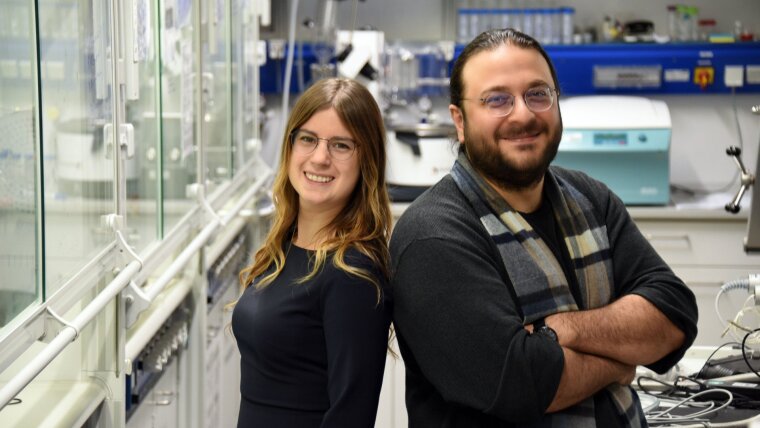
- Light
- Research
Published: | By: Marco Körner
This year, the Carl Zeiss Foundation’s funding for interdisciplinary research topics goes twice to the University of Jena: Starting 1st February, 2024, the funding for Dr Sina Saravi begins, who is developing optical neural networks to make image recognition faster and more resource-efficient. And since 1st January, 2024, Dr Desirée Leistenschneider has been funded for developing innovative batteries. Both research groups receive 1.5 million euros each for a period of five years.
Image recognition at the speed of light
“Put simply, my team and I are working on a kind of intelligent, nanostructured camera lens,” explains Sina Saravi about his work on optical neural networks. He and his research group are developing stacks of nanostructured optical elements that change incoming light in a specific way. “One could imagine it as a layer made up of optical lenses – even though we don’t use lenses, but nanostructured nonlinear materials. And behind this layer, there are more of those,” he illustrates. “When we now point this system to an object or an image of an object, then this system can recognize the object. So, it can tell whether it’s looking at a house, a cat, or a person. And it does that literally at the speed of light.”
As a possible example where persons or things should be recognized as quickly as possible, he mentions driving motor vehicles. “Especially in autonomous driving, it’s of course crucial that the system recognizes as quickly as possible whether there is a child on the road or an object, which probably may be massive,” he explains.
He further states that energy consumption is becoming an ever-increasing problem in AI applications. “Conventional electronically based AI, such as ChatGPT, requires a lot of energy. On the one hand, vast amounts of data sets must be processed during creation – that is, training. On the other hand, the system must also perform calculations for each query in the actual application, the result of which is then output,” he clarifies. “As rapidly as such technologies are currently developed and as intensively as they are being used, they will sooner or later require more energy than we can produce on Earth.” He adds, “Of course, I don’t think this will lead to blackouts or anything like that, but I think it illustrates a fundamental problem of AI and its applications. However, optical AI systems can help conserve resources – at least in certain applications.”
Lightweight batteries made from inexpensive and recyclable materials
“There are already so-called metal-gas batteries,” introduces Dr Leistenschneider her project. Corresponding zinc-air batteries, for example, are widely used in hearing aids. “As the name suggests, the two electrodes are based on readily available materials: zinc on one side and air – or more specific, atmospheric oxygen – on the other,” she adds. Due to these materials, such batteries are lightweight, which is particularly advantageous for hearing aids. However, the disadvantage, explains the inorganic chemist, is that they are so-called primary batteries. That is, they cannot be recharged with energy. “Once a zinc-air battery is discharged, it is replaced by a new one. The old battery is recycled,” she summarizes. “And this is where my research project called ReAlBatt comes in.”
Specifically, Leistenschneider is working on aluminum-nitrogen batteries. “Theoretically, these batteries have a very high energy density. Additionally, aluminum is very readily available, lightweight, and inexpensive,” she explains. “There are also established recycling processes for this material. Our big goal, however, is to make these batteries rechargeable.” She and her team have already built initial cathode materials and cell prototypes that are now being researched and further developed.
This research field is still in its infancy, she explains. “To date, there is only one scholarly publication on aluminum-nitrogen batteries. But I consider it important to explore this technology in battery research,” Leistenschneider continues. “Especially in Thuringia, and specifically at the University of Jena, the environment is ideal for this. The Center for Energy and Environmental Chemistry (CEEC Jena), is explicitly designed to bring together expertise and develop new technologies up to market readiness.”
Albert-Einstein-Straße 6
07745 Jena Google Maps site planExternal link